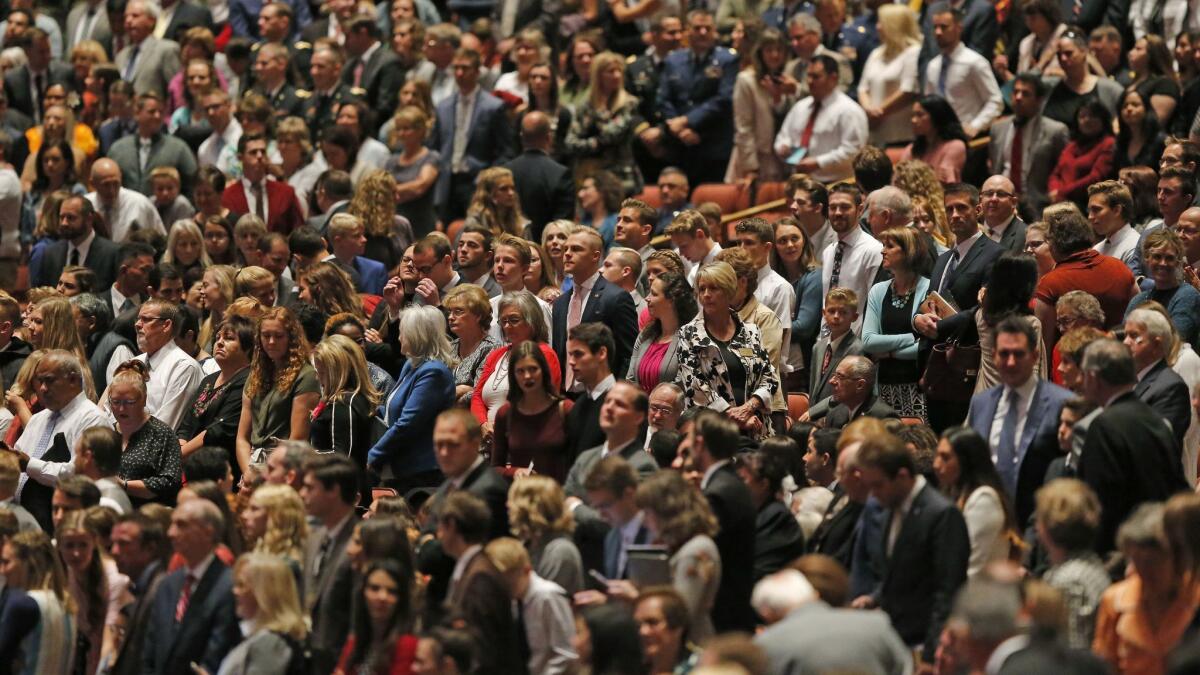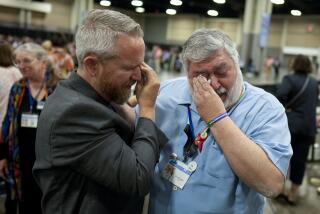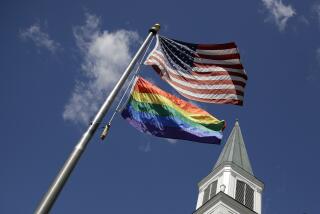Mormons’ church commitment each Sunday to be relaxed, leaders say

- Share via
Reporting from SALT LAKE CITY — Mormons will start spending less time at church each Sunday — two hours instead of three — after a change announced Saturday aimed at making worship more manageable for members around the globe.
The switch, which takes effect in January, is a significant one for Mormons, who since 1980 have been expected to attend all three hours each Sunday to be considered active members of the faith.
The news triggered widespread applause from members, with some posting celebratory memes on social media. It came during the Church of Jesus Christ of Latter-day Saints’ twice-yearly conference, where a leader also reaffirmed the faith’s opposition to gay marriage and its belief that gender is God-given and eternal.
“The senior leaders of the church have been aware for many years that for some of our precious members, a three-hour Sunday schedule at church can be difficult,” said Quentin L. Cook, a member of the Quorum of the Twelve Apostles, leaders who help run the church. “This is particularly true for parents with small children, primary children, elderly members, new converts and others.”
The three-hour commitment is a hefty one compared with some other religions’ Sunday services. Many Catholic, Lutheran and Methodist churches, for instance, offer weekly worship that lasts about an hour or an hour and a half, along with voluntary classes and other gatherings throughout the week.
Church President Russell M. Nelson called the adjustment a new “home-centered church” strategy that comes as the faith expands throughout the world. More than half of its 16 million members live outside the U.S. and Canada.
“The long-standing objective of the church is to assist all members to increase their faith in our Lord Jesus Christ and in his atonement,” Nelson said. “In this complex world today, this is not easy. The adversary is increasing his attack on faith and on families at an exponential rate. To survive spiritually, we need counter-strategies and proactive plans.”
Paulina Porras, a mother of 1-year-old twins, was thrilled with the news. She and her husband have to care for their girls during Sunday church time.
“Staying three hours is impossible,” said Porras, 29, of Logan, Utah. “Two hours we can do.”
Instead of attending two meetings each Sunday beyond the one-hour worship — such as Sunday school and men’s and women’s groups — members will attend one each Sunday, with the meetings rotating throughout the month, Cook said.
Marc Fish, an insurance company owner from Las Vegas, also lauded the change. Three hours each Sunday can be intimidating for potential converts and wayward members, and the change gives families the flexibility to weave in Gospel activities at home.
Fisher, 38, has seven children ranging in age from 7 to 25 who are busy with piano, volleyball and homework, he said. He plans to have more one-on-one talks with them.
“Schedules are crazy for a lot of families,” Fisher said. “Sometimes you hear in the church we’re caught up with checklists, the pressure and the stress of just meeting everything.”
While U.S. members are likely to welcome the new schedule, it seems to mainly reflect the church shifting its focus away from being centered in the American West, where most members live near chapels and can handle the three-hour Sunday commitment, or worship block, said Mormon scholar Matthew Bowman, an associate professor of history at Henderson State University in Arkadelphia, Ark.
“This change is geared toward making participation in the church more flexible and increasingly targeted toward smaller congregations: A shorter worship block means less volunteer demands upon the congregation, fewer jobs which need to be filled, and generally easier administration,” Bowman said in an email.
Church membership growth has decreased in recent years, with growth in 2017 being the slowest in 80 years, according to independent Mormon researcher Matt Martinich. The number of convert baptisms in 2017 reached the lowest level in 30 years, he said.
Martinich doesn’t think the Sunday change is aimed at increasing retention, but rather at using church resources and members’ time more efficiently. The switch could allow multiple congregations to use the same church building in places like Utah where membership is especially large. It also will let members do personal and family Gospel activities on their own time, he said.
The two-day Mormon conference kicked off a day after the faith announced it was renaming the famed Mormon Tabernacle Choir to drop the word “Mormon.” The singing group, now called the Tabernacle Choir at Temple Square, performed at the conference as they always do.
The name change followed a broader one the church announced earlier this year, ending use of the name “Mormon” as a general reference to the religion and instead using only its formal name, the Church of Jesus Christ of Latter-day Saints.
The Los Angeles Times and the Associated Press are monitoring the rebranding, but their stylebooks still allow for use of the word “Mormon” in articles about the faith.
More to Read
Sign up for Essential California
The most important California stories and recommendations in your inbox every morning.
You may occasionally receive promotional content from the Los Angeles Times.













